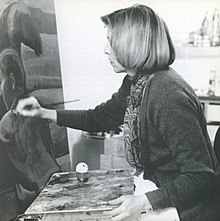Monique de Roux
Monique de Roux (born 1946 in Boulogne-Billancourt) is a French painter and engraver. She lives and works in Spain.

Biography
Sister of the writer Dominique de Roux, of the sailor Jacques de Roux, of the lawyer and politician Xavier de Roux and of the journalist Emmanuel de Roux, she grew up in Algeria until she was six before moving to Paris. During a visit in a museum, she experienced a first aesthetic shock in front of The Sleeping Gipsy by Henri Rousseau, soon followed by the one of the masters of Quattrocento, particularly Fra Angelico.
She studied at the École nationale supérieure des Beaux-Arts in Paris, specialized in engraving, from 1965 to 1968, and then completed her education the following year at the Real Academia de Bellas Artes de San Fernando in Madrid where she settled with her husband.
Her first solo exhibition was at the gallery La Maison pour tous in Paris in 1969. In the 70’s, she had numerous engraving exhibitions in Spain. Dominated by dark colors, her artwork is then characterized by dusk visions with troubling models, unmoving people and birds in a cage. She was awarded the engraving prize "Carmen Arozena" in 1980[1] and, four years later, the "Máximo Ramos" prize.[2]
At the same time, she became interested in painting. In 1984, she was selected for attended the courses of the painter Antonio López García at the Fine Arts Circle in Madrid. The following year, she moved with her family to Panama where she taught engraving in a studio of the Museum of Contemporary Art (MAC). This 4-years stay in Central America had a decisive influence on her art.[3] In addition to the natural Panamanian landscapes which reminded her of Henri Rousseau’s exoticism, it is the use of pure colors as a symbolic language which changes the perception of her oeuvre.
Representations of archetypal scenes characterized by an indefinable distress, her painting is like a luminous and enigmatic dream with a kind of timelessness that evokes some paintings by Zurbarán or Magic realism.
Back to Madrid, the Mapfre foundation awarded her the drawing prize "Penagos" in 1990.[4] Since, she regularly exhibits in Europe and in Central America.
In 2005, she achieved the reprint of her engraving work with the publisher Victor Galán. Five years later, the National Library of Madrid accepted the donation from the artist of 130 engravings which almost cover all of her graphic production.[5] In 2016, Monique de Roux was one of the engravers invited for artistic residency at the Xuyuan Center in Beijing, in collaboration with the Instituto Cervantes and the National Chalcography in Madrid. To mark the 400th anniversary of the death of Miguel de Cervantes, each artist created large etchings on the theme of the Knight-errant which were shown in Beijing at the end of their residency.[6]
Exhibitions (selection)
- 1994 : Galería Herold, Bruxelles. Galería Habitante, Panamá
- 1995 : Inter Art Galerie Reich, Köln
- 1996 : Galerie Alain Blondel, Paris
- 1997 : ARCO, Galería Seiquer, Madrid
- 1998 : Galería Habitante, Panama
- 1999 : Galerie Alain Blondel, Paris. Galería Tórculo, Madrid
- 2000 : Galería Nolde, Navacerrada, Madrid
- 2002 : Galería Habitante, Panama
- 2003 : Galería Van Dyck, Gijón. Galería Nolde, Navacerrada, Madrid
- 2007 : Inter Art Galerie Reich, Köln
- 2008 : Galerie Alain Blondel, Paris
- 2010 : Dibujos, Galería Pelayo47, Madrid. Galerie Alain Blondel, Paris
- 2013 : Moesta et Errabunda, Galerie Alain Blondel, Paris. Quand vient le soir, Galería José Rincón, Madrid
- 2014 : Galería Pelayo47, Madrid
Public collections
- Calcografía Nacional, Madrid
- Museo Bello Piñeiro, El Ferrol
- Museo del dibujo de Sabiñánigo (Huesca)
- Museo Español del Grabado Contemporáneo, Marbella/Málaga
- Museo Postal y Telegráfico, Madrid
- Fundación Cultural Mapfre, Madrid
- Biblioteca Nacional, Madrid
- Museo Caixa Nova, Orense
- Museo Insular Convento de San Francisco, La Palma (Canaries Islands)
Bibliography (selection)
- "Arte Español 78", ed. Lápiz.
- "Historia del grabado en España", de Antonio Gallego.
- "Pintoras Españolas Contemporáneas" de Raúl Chavarri.
- "Mujeres en el Arte Español 1900 - 1984" (Centro Cultural del Conde-Duque).
- "Les Cahiers Bleus." (Dominique Daguet)
- "Diccionario de Artistas Contemporáneos de Madrid", ed. Fernán Gómez Artes y Ediciones.
- "Tercera Mostra" (Unión FENOSA.)
- "Libro de Oro del Grabado", de la Galería Nela Alberca.
- "Encuentro conel Arte Actual", ed. GA Barcelona.
- "Diccionario de Artistas Contemporáneos en España" de Mario Antolín.
- "Oro Septiembre 2003" (VISA España.)
- "Ciento y... postalicas" (Homenaje a García Lorca de Correos y Telégrafos de España.)
- "Premios Penagos" (Catálogo de la Colección Mapfre.)
- "El canto quiere ser luz" (Endesa.)
- "Galería de Arte Rafael 1985 - 2005", ed. El pasaje de las letras.
External links
References
- "Archived copy" (PDF). Archived from the original (PDF) on 2016-03-04. Retrieved 2014-12-14.CS1 maint: archived copy as title (link)
- "Archived copy". Archived from the original on 2014-12-19. Retrieved 2014-12-14.CS1 maint: archived copy as title (link)
- http://hemeroteca.abc.es/nav/Navigate.exe/hemeroteca/madrid/cultural/1996/01/19/032.html
- http://hemeroteca.abc.es/nav/Navigate.exe/hemeroteca/madrid/abc/1990/12/28/042.html
- https://es-es.facebook.com/notes/biblioteca-nacional-de-espana/la-artista-monique-de-roux-dona-a-la-bne-130-estampas-de-su-obra/259795178368
- http://www.lavanguardia.com/vida/20161215/412643707773/artistas-espanoles-y-chinos-graban-sus-lecturas-del-idealismo-cervantino.html